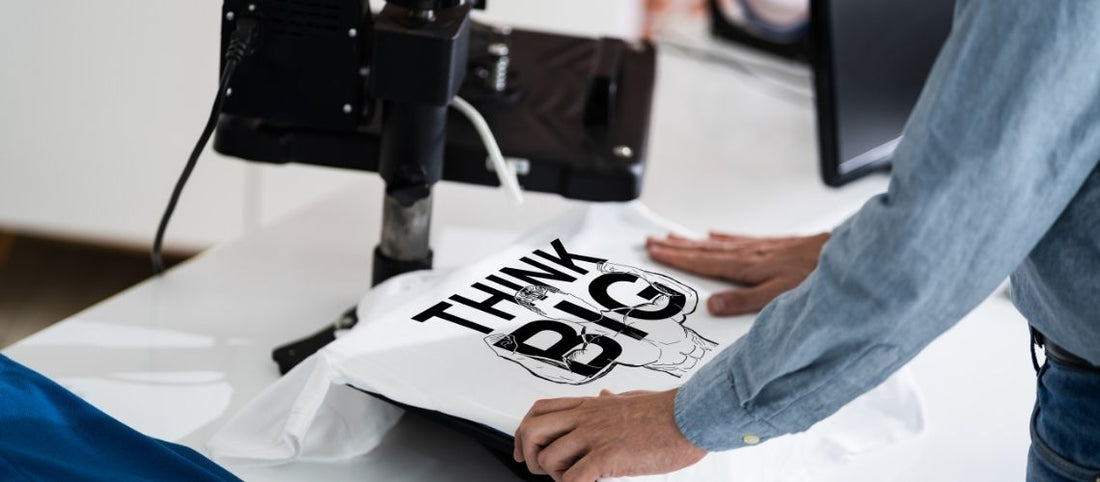Can UV DTF Go in the Dishwasher?

Can UV DTF transfers go in the dishwasher? The short answer is that many UV DTF-printed items can survive a trip or two through the dishwasher without immediate disaster, but it's not always guaranteed to hold up perfectly across repeated, high-heat wash cycles. Many factors—like ink formulation, adhesive quality, application technique and the specific wash settings—will decide how well your design endures. In other words, UV DTF can stand up to water and temperature far better than standard vinyl stickers, but to keep those vivid colors looking fresh for a long time, most experts still recommend hand washing.
What Is UV DTF Printing (and How Is It Different)?
UV DTF printing stands for "Ultraviolet Direct-to-Film" printing. It merges UV-curable ink technology with a decal-like transfer method to produce a durable, ready-to-stick design. Unlike cut vinyl decals or traditional stickers, UV DTF prints are layered with adhesive, color ink and often a white or clear backing that anchors everything onto your chosen surface. Here's a closer look:
The Printing Process
In UV DTF, a printer applies ink onto a transparent film in reverse order. That means the image is printed mirrored, so once applied, it appears correctly on your item. During printing, the inks are cured at once by UV light. This rapid, on-demand curing not only speeds up production but also creates a solid, somewhat glossy layer of ink that's known for resisting scratches and fading.
The Transfer Mechanism
After the ink is printed on the "A film," a second film (commonly called "B film" or "adhesive film") is laminated over it. This sandwich of adhesive and ink allows you to peel and stick the design onto your item in one piece. Once the decal is on the mug, tumbler or any smooth surface, you remove the top carrier sheet, leaving behind a tough ink layer securely bonded with adhesive.
Key Advantages
Ease of Application: With UV DTF, you don't have to weed or layer separate pieces for multi-color artwork; everything is already aligned and printed as one design.
Bold, UV-Resistant Colors: The inks are formulated to resist sun fading, which is a significant receive help for items exposed to outdoor conditions or frequent sunlight.
Versatility: You can apply UV DTF to many surfaces—metal, glass, ceramic, plastic and more—without needing a specialized coating (such as the polyester coating needed for sublimation).
Instant Curing: Because the inks cure via UV light, the print is essentially "locked in" at once. This yields a sturdy graphic that's not going to smudge or bleed as it transfers.
How It Differs from Other Methods
Versus Sublimation: Sublimation fuses dye into a polyester coating, so the image becomes part of the item. UV DTF sticks on top as a decal, but is more flexible about which surfaces it can bond to.
Versus Vinyl Decals: Regular vinyl relies on an adhesive-backed film, which can peel under heat and high-pressure water. UV DTF is a single, integrated ink layer and adhesive, making it more robust.
Versus Screen Printing: Industrially screen printed designs (often kiln-cured on ceramics or glass) can be extremely dishwasher-friendly because the ink fuses with the surface. UV DTF is closer to a "super sticker," albeit tougher than most standard decals.
Dishwasher Torture Test: What Can Happen to UV DTF Prints?
A dishwasher may look peaceful through the little window, but inside, it's a harsh environment. The swirling combination of heat, water pressure and detergent chemicals can challenge any decal. Here's how each element can affect a UV DTF print:
Heat and Drying Cycles
Most dishwashers run between 122°F (50°C) and 158°F (70°C), depending on the cycle. Some have a final heated drying stage that can push temperatures even higher. While UV-cured inks are not especially prone to melting at standard dishwasher temps, the adhesive layer under the cured ink might weaken if consistently exposed to very high heat. Over time, elevated temperatures can soften or degrade some adhesives, especially if the item is subjected to repeated "sanitize" or heavy-duty wash cycles.
High-Pressure Water Jets
Dishwashers aren't just gently rinsing; they spray water at enough force to blast off stuck-on food. With repeated cycles, pressurized water can probe at edges or corners where the decal isn't perfectly sealed. If even a small edge begins to lift, detergent and water could creep underneath, gradually prying the decal away.
Strong Detergents
Dishwasher pods or powders often contain caustic or alkaline agents, enzymes and sometimes bleach. While UV-cured ink tends to resist fading or chemical dissolution, the adhesive layer can be more vulnerable. Over dozens of cycles, these chemicals might dull the surface finish of the decal or cause micro-separation. If the item is metal, repeated exposure to detergent and heat can cause microscopic expansions in the surface, occasionally undermining the bond between the adhesive and the metal.
Adhesion Quality and Surface Prep
Perhaps the biggest factor is how well the design was applied in the first place. Any trace of oil, dust or residue on your mug will reduce the strength of the adhesive. Proper cleaning with isopropyl alcohol is crucial before applying the decal. Pressing out air bubbles and ensuring full contact also matters greatly. If the transfer is done flawlessly, the design has a better chance of withstanding dishwasher punishment.
Expansion and Contraction
Items in the dishwasher go from hot to cooler temperatures when rinsed or removed. This thermal shift can cause slight expansions and contractions in both the decal and the item's surface (especially if it's glass or certain metals). Over time, that could lead to tiny cracks or adhesion stresses. Although UV DTF is designed for robustness, repeated thermal shocks will chip away at the bond.
Real-World Results: How Well Does UV DTF Hold Up?
Experiences vary widely, largely because UV DTF prints can come from many manufacturers with slightly different ink or adhesive formulations. End-users also have different dishwashers, detergents and application methods. Here's what tends to happen in practice:
Many Users Report Surprising Strength
A number of crafters and small businesses have tested UV DTF prints by running them repeatedly through a home dishwasher. Some report that their decals stay vivid and intact after numerous cycles, showing no peeling or fading. This is especially common when surfaces are thoroughly cleaned prior to application and when the design is allowed to "rest" or "cure" on the item for a day or two before washing.
Occasional Failures in Harsh Conditions
On the other hand, some people mention that certain UV DTF stickers peel or loosen after just a few dishwasher runs, especially on high-temp sanitize cycles. When the water runs extra hot or the detergent is particularly strong, edges can lift. In some cases, the design may come off in one piece, functioning like a big plastic film that's easy to peel away once compromised. This discrepancy in success rates can often be traced back to:
- Different adhesive or ink formulas.
- Inadequate cleaning of the item before application.
- Poor surface coverage or trapped air bubbles.
- Using high-heat or extended wash settings that degrade the bond faster.
Factory-Printed vs. DIY-Printed
UV DTF decals produced in large manufacturing settings may have improved processes, specific ink blends or a special adhesion promoter that ensures a rock-solid grip. DIY setups might use more generic films or vary in print thickness (especially in how much varnish or white ink is laid down). As a result, some home-printed UV DTF graphics aren't as durable in the dishwasher as those purchased from a reliable supplier.
Cautious but Hopeful Consensus
Across crafting groups and product pages, the usual guidance is that UV DTF can manage water exposure extremely well—after all, it's a waterproofed, cured layer of ink. The question is whether repeated assaults by heat and chemicals will eventually degrade the bond. Many have found that if you follow good prep and application protocols, your decal can survive quite a few cycles with minimal or no damage. Still, for guaranteed longevity, it's often recommended to stick to hand washing.
Newer "Dishwasher-Grade" Films
Because dishwasher safety is such a hot topic, some suppliers now offer specialized UV DTF films or adhesives marketed as "dishwasher safe." These materials aim to resist higher temperatures and stronger detergents. Early reviews show better survival rates, though they're not always perfect. It's a sign that the industry is evolving rapidly to address consumer needs—giving hope that even more durable UV DTF solutions will keep appearing.
Tips to Make Your UV DTF Prints Last (Even in the Dishwasher)
If you want to push your UV DTF projects as far as they can go without resorting exclusively to hand washing, here are some best practices to strengthen their dishwasher endurance:
Clean Thoroughly Before Application
Residue on cups or bottles is the Achilles' heel of any adhesive. Wipe your surface with 70–90% isopropyl alcohol before you apply the transfer. Make sure it's fully dry (the alcohol usually evaporates quickly) and free of dust or fingerprints. This single step can dramatically boost how well your decal bonds.
Apply Firm Pressure
Use your fingers, a squeegee or a credit card wrapped in a soft cloth to rub the decal onto the surface with consistent, firm pressure. Start from the center and collaborate outward, pushing out any air bubbles. The more complete and bubble-free the contact between the decal and the item, the less chance for water to sneak underneath.
Allow Adequate "Cure" Time on the Item
Even though the inks are instantly UV-cured during printing, the adhesive side can take some time to form a permanent bond with your mug or glass. Many recommend waiting at least 24 hours before exposing the item to water or heat. If you're aiming for dishwasher resilience, some prefer waiting 48 hours. This waiting period helps the adhesive "set" fully.
Use a Gentle Dishwasher Cycle
If you must toss your UV DTF-printed mug in the dishwasher, pick a gentler or cooler cycle. Many dishwashers have an "eco," "delicate," or "china" setting that uses lower temperatures and lighter water pressure. Avoid the sanitize function or extra-hot drying if possible, as high heat accelerates adhesive degradation.
Place on the Top Rack
The heating element in many dishwashers is at the bottom, so the top rack is typically a bit cooler. Placing your decorated items farther from direct heat can prolong the life of the decal. It also keeps them from too much jostling among other dishes.
Consider a Protective Topcoat
Some crafters who produce custom tumblers or glassware apply a clear resin or epoxy over the UV DTF design to seal it completely. This can create an even stronger barrier against abrasion or moisture. However, not everyone wants the extra steps or the thick, glossy finish that resin leaves. If a spray varnish or clear sealant is used, confirm it's food-safe once cured and that it won't complicate future cleaning.
Design with Durability in Mind
Large blocks of connected color and shapes are more likely to stay put than intricate, skinny text or super-fine lines. Detailed designs can peel more easily at their thin edges. If you know your piece will be often dishwashed, consider bolder shapes rather than hairline details.
Hand Wash to Extend Lifespan
Even if your decal is labeled as dishwasher-friendly, hand washing in warm, soapy water with a soft sponge is undeniably gentler. You'll avoid repeated high-heat blasts and the intense water pressure of a machine cycle. If your goal is maximum longevity, hand washing stays the simplest and safest routine.
UV DTF vs. Other Printing Techniques: Dishwasher Durability Showdown
When it comes to drinkware and other kitchen items, dishwasher durability matters. Here's how UV DTF compares to other popular printing methods for longevity in dishwashers:
UV DTF
Dishwasher Potential: Decent to good, especially if carefully applied and washed on a gentler cycle. With newer "dishwasher-grade" UV DTF films, longevity is improving.
Pros: Wide material compatibility (glass, metal, plastic, ceramic), easy full-color prints, strong weather resistance, minimal fading from sunlight.
Cons: Still a decal at heart, so extended exposure to high heat, strong detergents and repeated cycles can erode adhesion over time.
Sublimation
Dishwasher Potential: Often excellent, because the ink literally becomes part of the item's polyester coating. When done on top-quality sublimation blanks (like premium ceramic mugs), these prints can endure hundreds of dishwasher cycles.
Pros: Vibrant, durable, no physical layer to peel off, widely accepted as the gold standard for dishwasher-safe custom mugs (when using the right materials).
Cons: Requires special equipment (heat press or mug press), can only be done on substrates that have a polyester or polymer coating and cannot print white unless the blank is white.
Vinyl Decals
Dishwasher Potential: Generally poor. Most vinyl suppliers do not guarantee dishwasher safety. The combination of hot water, pressure and detergent often leads to peeling or bubbling.
Pros: Accessible, easy to cut custom shapes, no specialized printer needed.
Cons: Not reliably dishwasher-safe; typically recommended for hand wash only. Even normal use can cause issues if the adhesive fails or the vinyl edges lift.
Screen Printing / Fired Ceramic Ink
Dishwasher Potential: Typically very high if done professionally and fired onto a mug or glass. Commercially printed drinkware often survives numerous dishwasher cycles without significant wear.
Pros: Long-lasting, strong adhesion and can be used on large production runs.
Cons: Requires more specialized setup (screens, kilns or curing ovens), not as convenient for one-off designs and color limitations can exist with certain inks.
UV Ink Direct Printing (without DTF)
Dishwasher Potential: If a UV printer prints directly onto an item and the ink is fully cured, it can be quite durable. However, surface tension and adhesion can still pose challenges on slick surfaces like glass or metal. Some direct-printed items endure well, but others have issues with ink flaking. In many cases, a primer or adhesion promoter is needed.
Pros: No film to apply, instant ink curing, can do short runs with custom art.
Cons: Must ensure perfect adhesion. Some surfaces demand specialized pretreat or promoter chemicals.
Hand-Wash or Dishwasher? Practical Recommendations
In an ideal world, you'd treat every carefully decorated mug or tumbler with gentle, lukewarm hand washing. That's certainly the safest route. But let's be realistic—sometimes the dishwasher is just too convenient to resist. Here's how to think about it:
If You Want Maximum Lifespan
Always hand wash. Use mild soap, avoid abrasive scrubbers and rinse promptly. By sidestepping the punishing mix of heat, pressure and harsh detergents, you'll help ensure your UV DTF designs look brand-new for as long as possible.
If You Need to Dishwasher Occasionally
- Wait at least 24 to 48 hours after applying the decal before the first wash, so the adhesive can fully bond.
- Place your item on the top rack, away from the heating element.
- Use a shorter or cooler cycle if you can. Skip the "sanitize" mode or extra-hot drying.
- Monitor the design after each wash. If you see any corner lifting, it's probably time to switch to hand washing going forward.
Balancing Convenience and Care
For many everyday cups or casual items, it may be worth letting them run through a milder dishwasher cycle from time to time. If they show no signs of wear, great. If you notice slight peeling or dulling, then reserve them for hand washing. This pragmatic approach collaborates for those who love customizing cups but don't want to babysit them forever.
Commercial vs. Personal Use
If you're selling UV DTF-decorated drinkware, it's often wise to include a care card recommending hand washing for best results. That way, you manage customer expectations. Some folks might throw it in the dishwasher anyway (and maybe it'll be fine), but you've already informed them that repeated machine washing could shorten its life. If they come back for a replacement, at least they were aware of the recommended care.
Avoid the Microwave
Though the microwave is a separate appliance from the dishwasher, it's often another question that pops up with custom designs. UV DTF includes adhesives and layers that aren't meant for high-heat microwaving. There's a risk of the design or adhesive degrading, not to mention potential safety concerns if the film overheats. If your item is a mug that's regularly used for hot beverages, it's better to play it safe and skip microwaving altogether.

